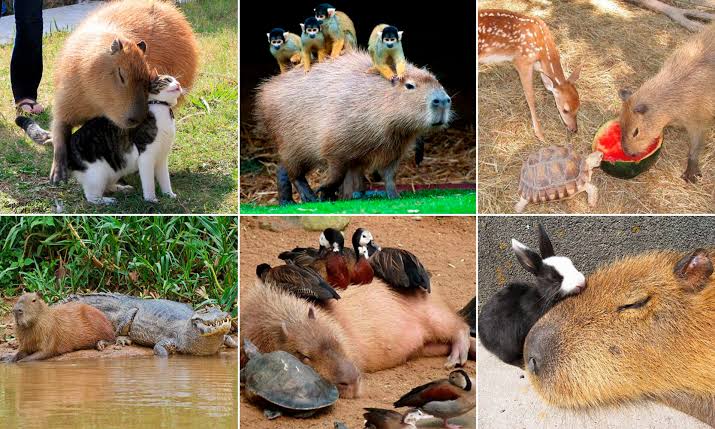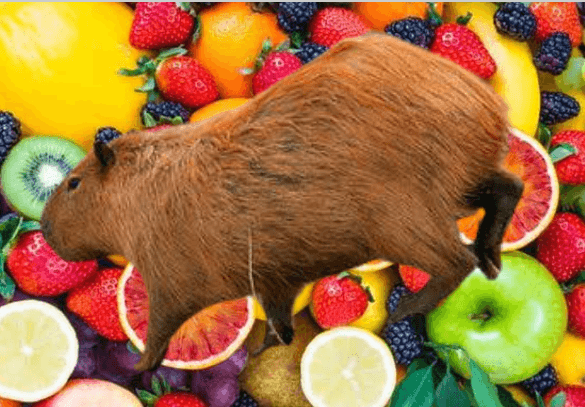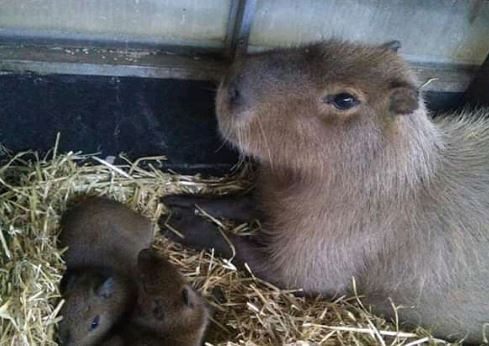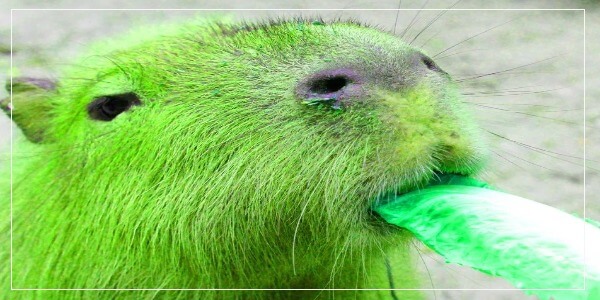Can Capybaras Eat Their Own Babies?
Capybaras are adorable, social, and fascinating creatures that are often found lounging around in the waters of South America. These furry rodents are known for their gentle nature and love of communal living. However, as with any animal, there are often some misconceptions about their behavior. One such question that has been asked time and time again is whether capybaras eat their own babies. This topic is sure to raise eyebrows and pique your curiosity, so let’s dive into it and discover the truth behind this controversial claim.
No, capybaras do not typically eat their babies. In fact, they are known to be very nurturing and protective parents. Capybara mothers are known to be very attentive to their young, nursing and grooming them regularly to ensure their health and safety.
While there may be some rare cases where capybaras might eat their young, this is not normal behavior for them. In general, capybaras are social animals that live in groups, and they take care of each other, including their offspring.
It is worth noting that in the wild, some animals may be forced to eat their young if they are under extreme stress or if they perceive a threat to their own survival. However, this is not a common occurrence among capybaras.
How capybara mothers care for their babies
Capybara mothers are very attentive and caring toward their offspring. They protect and nurture their young from birth, and help them develop the skills they need to survive in the wild. Through this process, capybara mothers create strong bonds with their young and ensure the survival of their species.
- Birth and Bonding: When a female capybara gives birth, she will typically have a litter of 2-8 babies called pups. The mother will immediately bond with her newborns and begin caring for them. She will clean them and lick them to remove any remaining fluids, and then allow them to nurse.
- Nursing: Capybara mothers have a high milk production rate, and their milk is rich in nutrients that are essential for the growth and development of their young. The mother will nurse her pups frequently throughout the day, often allowing them to nurse for up to 10 minutes at a time.
- Protection: As capybara pups are very vulnerable in their early days, the mother will keep a close eye on them to protect them from predators. She will also use her body to shield them from the sun, wind, and rain, and will often sleep with them at night to keep them warm.
- Socialization: Capybaras are highly social animals, and the mother will begin to introduce her pups to the rest of the group when they are around one week old. This allows the young capybaras to socialize with other members of the group, learn important social behaviors, and form bonds with other capybaras.
- Teaching: As the pups get older, the mother will begin to teach them important skills that they will need to survive in the wild. This includes things like foraging for food, identifying predators, and finding shelter. The mother will lead by example and demonstrate these skills to her young.
- Weaning: Capybara pups will nurse for around 16 weeks, after which they will begin to eat solid food. The mother will start to wean her young gradually, allowing them to nurse less frequently until they are fully weaned. During this time, the mother will also continue to teach her young about foraging and other survival skills.
Animal Infanticide (What to Know)
Animal infanticide is the act of killing offspring by their own parents or other adults in a social group. This behavior is observed in various species, including rodents, primates, and carnivores, although it is relatively rare. The reasons behind animal infanticide vary depending on the species, but they are usually related to reproductive strategies, resource competition, and predation.
In some species, such as rodents and carnivores, infanticide occurs when a new male takes over a group or territory. The new male may kill the offspring of the previous male to bring the females into heat and increase his own chances of reproduction. This strategy is called the Bruce effect, named after the scientist who first observed it in mice. The Bruce effect can also occur in primates, where males may kill infants to bring the females into estrus.
In other species, infanticide may occur as a result of resource competition. For example, in some primates, like langurs, infanticide occurs when males take over a group and kill the infants of the previous male to reduce competition for resources. This behavior is called sexual selection infanticide, as it is related to competition for mates. Similarly, in some carnivores, like lions, infanticide occurs when males take over a pride and kill the cubs of the previous male to reduce competition for food and resources.
Infanticide may also occur as a result of environmental or social stress. For example, in some species, like rats and hamsters, mothers may kill their own offspring when resources are scarce or when they are stressed by overcrowding. This behavior is called maternal infanticide, and it is thought to be a mechanism for population control.
In some species, infanticide may also be related to predator avoidance. For example, in some bird species, like the snowy owl, parents may kill the weakest chick in the brood to reduce the risk of predation. This behavior is called brood reduction, and it is thought to be a strategy for increasing the survival chances of the remaining offspring.
Animal infanticide is a rare but complex behavior that is observed in various species. The reasons behind infanticide vary depending on the species, but they are usually related to reproductive strategies, resource competition, and predation. While infanticide may seem cruel or unnatural, it is an important adaptive strategy that helps these species survive and thrive in their environments.
Animal Infanticide In Capybaras
As mentioned above, Animal infanticide is a behavior commonly observed in many animal species, including capybaras. Capybaras are social rodents that inhabit regions of Central and South America. They are known to live in large groups, and their social structure is based on a dominant male that mates with several females.
Infanticide in capybaras occurs when a male takes over a group and kills young offspring that are not his own. This behavior is believed to be an adaptive strategy that allows the new male to reproduce with the females and increase his own genetic fitness.
The process of infanticide in capybaras typically follows a few steps. First, the male will invade the territory of the previous dominant male and fight with him to establish dominance. Once he has secured his position, he will begin to mate with the females in the group.
During mating, the male will become aggressive towards any young offspring that are not his own. He will often chase them, bite them, or throw them against hard surfaces such as rocks or trees. The mother capybara will typically try to protect her young, but the male will often overpower her.
If the male is successful in killing the young offspring, he will then begin to mate with the females in the group. This behavior is believed to increase his own genetic fitness by eliminating genetic competition and allowing his own offspring to survive.
While infanticide in capybaras is a natural behavior, it can have negative impacts on the overall population. If too many young are killed, the population may decline, and the social structure of the group may become disrupted. Additionally, the aggression and violence associated with infanticide can be traumatic for the surviving young and their mothers.
In conclusion, infanticide in capybaras is a complex behavior that is driven by evolutionary pressures. While it may provide benefits to the male that engages in it, it can also have negative impacts on the population as a whole. Understanding the steps involved in this behavior can help researchers develop strategies to mitigate its effects and promote the health and well-being of capybaras in the wild.
How to Prevent Capybara Infanticide
If you own or work with capybaras, it is important to take steps to prevent this behavior. Here are ten steps you can take to prevent capybara infanticide:
- Separate male capybaras from females and their young. Male capybaras should be kept in a separate enclosure from females and their young. This will reduce the chances of infanticide occurring.
- Ensure adequate space. Capybaras need ample space to move around and socialize. Provide them with a large enclosure that has plenty of hiding places, toys, and natural elements like rocks and logs.
- Provide ample food and water. Capybaras require a diet that is high in fiber, and they need access to clean water at all times.
- Introduce males to females slowly. If you need to introduce male capybaras to females, do so slowly and under close supervision. Make sure the males are well-fed and not aggressive toward the females.
- Monitor behavior closely. Watch for any signs of aggression or territorial behavior. If you notice anything concerning, separate the animals immediately.
- Consider neutering males. Neutering male capybaras can help reduce their aggression and territorial behavior.
- Keep the enclosure clean. Regularly clean the enclosure to prevent the buildup of waste and bacteria that can cause illness.
- Provide a variety of enrichment activities. Capybaras are intelligent animals that need stimulation to prevent boredom. Provide toys, puzzles, and other activities to keep them occupied.
- Hire experienced staff. If you are caring for capybaras, make sure you have experienced staff who are knowledgeable about their behavior and needs.
- Consult with a veterinarian. Regular veterinary care is important to keep capybaras healthy and identify any potential health issues before they become serious. Consult with a veterinarian who has experience working with capybaras to ensure their well-being.
Safety measures to take if Capybara Infanticide occurs
If this occurs, here are 10 safety measures to take:
- Remove the capybara from the area where the infanticide occurred to prevent any further harm to the remaining offspring.
- If there are other capybaras in the same enclosure, separate them to prevent any potential aggression toward the surviving offspring.
- Carefully and quickly remove the deceased offspring from the enclosure and dispose of it properly to prevent the spread of disease.
- Ensure that the surviving offspring is healthy and uninjured. If it is injured, seek veterinary care immediately.
- Monitor the behavior of the capybara and the surviving offspring closely, as the capybara may continue to show aggression towards the offspring.
- Provide a safe and secure environment for the surviving offspring, such as a separate enclosure or protected area, to prevent any potential harm from the capybara.
- Provide additional food and water to the surviving offspring, as the mother may have stopped nursing or caring for the offspring.
- Seek the advice of a veterinarian or animal behaviorist to determine the best course of action and potential solutions for the situation.
- Consider removing the capybara from the group permanently if it continues to exhibit aggressive behavior towards its offspring or other capybaras.
- Implement measures to prevent future infanticide, such as providing adequate space and enrichment for the capybaras and ensuring that they are not under any undue stress.
Conclusion
In conclusion, while capybara infanticide is a rare occurrence, it has been documented in the wild and in captivity. However, this behavior is not a result of the capybara intentionally eating its own offspring, but rather a form of aggression or a response to environmental stressors. Capybaras are generally docile and social animals, and infanticide is not a common behavior for them.
If capybara infanticide does occur, it is important to take immediate safety measures to prevent any further harm to the surviving offspring and to seek professional advice from a veterinarian or animal behaviorist. It is also important to provide a safe and secure environment for the capybaras to prevent future infanticide and to address any potential sources of stress.
Overall, while capybara infanticide is a distressing behavior, it is important to understand that it is a rare occurrence and not a natural behavior for these animals. By providing a suitable and stress-free environment for capybaras, we can reduce the likelihood of infanticide and ensure the health and well-being of these fascinating animals.


![Why Do Capybaras Not Have Tails? - [Answered] Why Do Capybaras Not Have Tails](https://capybaratips.com/wp-content/uploads/2023/03/Capy-Tail-250x200.webp)

![How Long Do Capybaras Live? - [Answered] How Long Do Capybaras Live](https://capybaratips.com/wp-content/uploads/2023/03/Capybara-Pix-250x200.webp)




